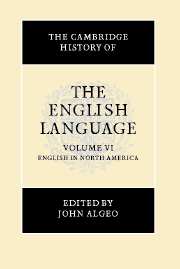Book contents
- Frontmatter
- 1 EXTERNAL HISTORY
- 2 BRITISH AND AMERICAN, CONTINUITY AND DIVERGENCE
- 3 BRITISH AND IRISH ANTECEDENTS
- 4 CONTACT WITH OTHER LANGUAGES
- 5 AMERICANISMS
- 6 SLANG
- 7 DIALECTS
- 8 AFRICAN-AMERICAN ENGLISH
- 9 GRAMMATICAL STRUCTURE
- 10 SPELLING
- 11 USAGE
- 12 CANADIAN ENGLISH
- 13 NEWFOUNDLAND ENGLISH
- 14 American English Abroad
- Glossary of Linguistic Terms
- Bibliography
- Index
- THE CAMBRIDGE HISTORY OF THE ENGLISH LANGUAGE
3 - BRITISH AND IRISH ANTECEDENTS
Published online by Cambridge University Press: 28 March 2008
- Frontmatter
- 1 EXTERNAL HISTORY
- 2 BRITISH AND AMERICAN, CONTINUITY AND DIVERGENCE
- 3 BRITISH AND IRISH ANTECEDENTS
- 4 CONTACT WITH OTHER LANGUAGES
- 5 AMERICANISMS
- 6 SLANG
- 7 DIALECTS
- 8 AFRICAN-AMERICAN ENGLISH
- 9 GRAMMATICAL STRUCTURE
- 10 SPELLING
- 11 USAGE
- 12 CANADIAN ENGLISH
- 13 NEWFOUNDLAND ENGLISH
- 14 American English Abroad
- Glossary of Linguistic Terms
- Bibliography
- Index
- THE CAMBRIDGE HISTORY OF THE ENGLISH LANGUAGE
Summary
Introduction
From the time it became a secure sea-lane following the collapse of the Spanish Armada in the late 1580s until well into the twentieth century, the North Atlantic brought people from all parts of the British Isles to a new life in what became the United States. Emigrants represented a broad sampling of lower and middling ranks, but few at either extreme of the social spectrum, as the latter lacked either the motivation or the means to come. These emigrants usually came voluntarily and were often accompanied by fewer material possessions than such intangibles as their hopes and beliefs. They included tens of thousands of indentured servants who sold years of labor for passage and sometimes training in a trade. Involuntary emigrants included London paupers and orphans and Irish military transportees in the seventeenth century and convicts in the eighteenth, but in proportion far fewer than to Australia and other British colonies.
Whatever their station and however meager their belongings, all emigrants brought their speech habits, usually untutored ones. Some were bilingual in a Celtic language, but with few exceptions and in ways reflecting the distinct history and culture of their regional origins, these people spoke either English or Scots (the latter being the close sibling to English that achieved national, autonomous status as the literary and governmental language of Scotland in the sixteenth century).
- Type
- Chapter
- Information
- The Cambridge History of the English Language , pp. 86 - 153Publisher: Cambridge University PressPrint publication year: 2001
- 23
- Cited by

